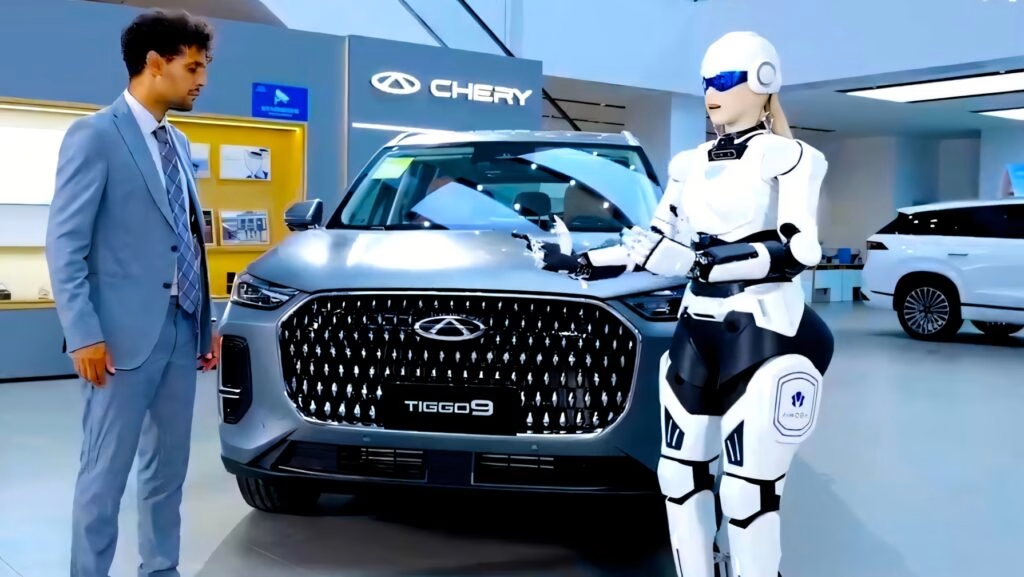Chery, a prominent Chinese automaker, is making waves in the automotive industry with its innovative approach to car sales. Imagine walking into a dealership and being greeted not by a human salesperson, but by a humanoid robot designed to assist you. This is exactly what Chery is aiming for with its latest creation, Mornine, which was showcased at the Shanghai Auto Show.
What Can Mornine Do?
Mornine is not just any robot; it’s a humanoid with a striking appearance that resembles a Stormtrooper, complete with long hair and a unique design. While some might find its aesthetics a bit unconventional, the functionality is what truly matters. Mornine is equipped with DeepSeek AI technology, allowing it to walk, talk, and interact with customers. It can serve drinks and answer questions about various car models, making it a potential game-changer in how dealerships operate.
The price tag for these robots is estimated to be around $60,000 each, which has raised eyebrows among dealers. While some are hesitant to commit to purchasing one without knowing the final price, Chery plans to deliver 220 units to dealerships this year. One Mornine robot is already in action at a showroom in Malaysia, providing a glimpse into the future of car sales.
Why Use Robots in Showrooms?
Chery’s strategy is rooted in understanding the preferences of younger Chinese consumers, who are increasingly tech-savvy and drawn to innovative experiences. By integrating Mornine into their showrooms, Chery hopes to attract more foot traffic and create a unique selling proposition that sets them apart from competitors. The idea is that a robot can enhance the customer experience, making it more engaging and informative.
But Chery’s ambitions extend beyond just selling cars. The company envisions a future where its Aimoga robot business becomes a significant part of its operations, potentially overshadowing its traditional automotive sales. This includes not only humanoid robots like Mornine but also robotic pets for those who might not want the responsibilities of a real dog.
The Bigger Picture: Robots in the Automotive Industry
Chery isn’t alone in its pursuit of robotic integration. Other major players in the automotive sector, such as Tesla and Hyundai, are also investing heavily in robotics. Hyundai’s acquisition of Boston Dynamics in 2021 highlights the growing trend of using agile humanoids in manufacturing and assembly lines. Mercedes has already begun deploying robots in its Berlin production facility, showcasing the potential for automation to streamline operations and reduce costs.
The reality is that robots are becoming increasingly common in various industries, and the automotive sector is no exception. They offer numerous advantages, including the ability to work without breaks, never call in sick, and perform tasks with precision. As technology continues to advance, it’s not far-fetched to imagine a future where robots play a central role in both manufacturing and customer service.
Is This the Future We Want?
While the idea of robots selling cars might seem futuristic, it raises important questions about the role of technology in our lives. Are we ready to embrace a world where humanoid robots assist us in everyday tasks? For many, the answer is yes, especially as we become more accustomed to AI and automation in various aspects of life.
However, there’s also a sense of nostalgia associated with human interaction, particularly in high-stakes environments like car buying. The warmth of a human touch, the ability to read body language, and the nuances of personal interaction are hard to replicate with machines.
The big takeaway? Embracing technology like Mornine isn’t about replacing human connection; it’s about enhancing the experience. As we navigate this evolving landscape, consider how one small change—like engaging with a robot in a showroom—could reshape your perspective on technology in our daily lives. Start with one change this week, and you’ll likely spot the difference by month’s end.

